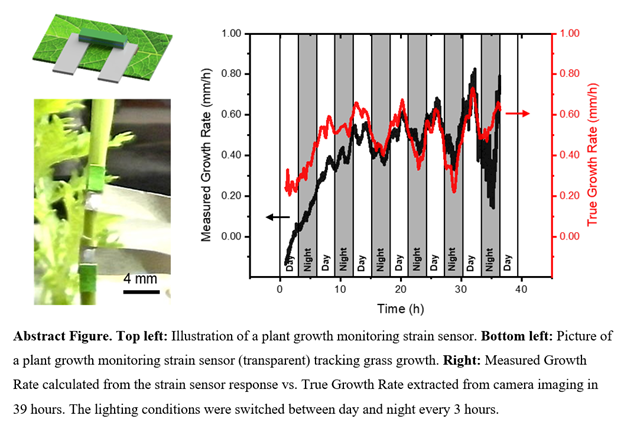2023 AIChE Annual Meeting
(181h) Highly Stretchable Wearable Electronics for Remote, Autonomous Plant Growth Monitoring
Additional manufacturing steps are needed to address these issues from the fabrication of a strain sensing film (SSF) to an applicable plant growth sensor, such as encapsulation. This further brought up the challenges of how to allow external electrical measurement after encapsulation and maintaining its proper functions. Current methods usually adopted solvent or mechanical processing on the encapsulation layer to make vias for electrical connections, which are not compatible with soft, stretchable, polymer-based devices. Here, we have developed a placeholder-assisted encapsulation method and a PEDOT:PSS/SWCNT composite electrode ink to address the above challenges. We developed a device fabrication process that achieved full encapsulation of both the SSF and the electrode component of the strain sensor, protecting the film from interacting with humidity, and leading to prolonged environmental stability under strain. On the other hand, the composite electrode ink relieved the mismatch of stiffness between the electrode and the film, leading to better device performance reliability under slow stretching rates. As a result, we successfully manufactured a lightweight and transparent stretchable strain sensor with high environmental stability, long-term reliability, and reproducibility.
Before manufacturing the strain sensor, we fabricated a high-performance SSF that can reach a strain sensing range of ~700%. To simultaneously achieve high stretchability, sensitivity, and linearity, the ink for SSF fabrication was designed by blending Zonyl and Li:TFSI in PEDOT:PSS solution. A meniscus-guided printing (MGP) technique was used in film fabrication due to its ability to tune molecular assembly during the printing process and the potential of large-scale manufacturing. Interestingly, a two-fold increase in strain sensing range was observed when the strain sensor was printed in the evaporation regime, where the thinnest films were formed. By AFM and GIWAXS characterizations, we proposed and verified our mechanism of how printing speed controls the strain sensing performance through the confinement effect: In thin films printed in the transition regime, crack size development is confined because of the limit of crack development in the vertical direction, and crack initiation is postponed because of the confined crystallinity and higher stretchability. With the novel fabrication technique and the high-performance SSF, we were able to precisely track plant growth with minimal interference.
By combining the strain sensor with a custom-built wireless autonomous resistance measurement system, remote, autonomous tracking of plant growth has been successfully achieved to unveil the circadian rhythm of leaf elongation challenging to obtain using other methods. The electrode parts of the strain sensor were attached to a grass with removable adhesives so that the middle part of the sensor is freestanding and can be fully stretched while the grass was growing. The measured grass growth rate recorded from the strain sensing performance matched well with the true growth rate measured by camera imaging. Peaks of grass growth rate were observed in the middle of the days and nights, indicating the ability of our strain sensor to pick fine patterns of grass growth rate that demonstrate the circadian rhythms of the plant. With the ability to track plant growth precisely, remotely, and autonomously with minimal interference to the plant, our strain sensor has a broad range of applications to further serve as a tool for studying plant biology problems in the future.
To further apply the stretchable strain sensor to long-term, remote, autonomous, and precise plant growth monitoring, our ongoing and future work will focus on three aspects: (1) Develop a patterned ultra-stretchable strain sensor for long-term plant growth monitoring. A larger stretchability of the strain sensor is always preferred to achieve plant growth monitoring at a longer time scale such as weeks or months. By designing the device configuration and the pattern of the strain sensor with a direct pen-writing process, we have obtained an SSF with a strain sensing range of over 1000%. We aim to utilize this novel patterned strain sensor in long-term plant growth monitoring. (2) Tuning sensitivity, reversibility, and strain sensing range of the strain sensor by controlling micro and nanoscale crack morphology development during stretching. The relatively poor reversibility of our current strain sensor limits its repeatable use, and a brand-new sensor is required for every test. By controlling the elastomer substrate, ink concentrations, and fabrication details, we are aiming to control the micro and nanoscale crack morphology of the strain sensor and improve the sensor reversibility while maintaining a large strain sensing range. (3) Apply the developed wearable strain sensors on various model plants and tissues for studying more complicated plant biology-related problems. For example, circadian rhythms have also been observed in plants' stomata conductance and carbon assimilation How environmental changes, plant activities on the molecular level, and plant growth correlate with each other is an interesting topic and can be further studied with our strain sensor.
